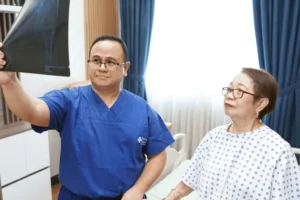Wound healing is a complex process that requires careful attention to various factors to ensure a positive outcome. One crucial step in this journey is dead tissue removal, a medical procedure that significantly enhances the body’s ability to heal wounds properly. Without timely and proper removal of dead tissue, wounds can become chronic, infected, and difficult to treat.
At Kalingap Wound Care Clinic, healing goes beyond just treating wounds. Rooted in Filipino values of kalinga (care) and lingap (nurture), the clinic combines advanced medical treatments with compassionate, patient-centered care. This holistic approach ensures not only effective wound treatment but also empowers patients, restoring dignity and improving their quality of life—especially for underserved communities in Metro Manila.
What is Dead Tissue and Why Does It Matter?
Dead tissue, often called necrotic tissue, refers to the damaged or non-viable skin, muscle, or other tissues in or around a wound that no longer support healing. This tissue can appear black, brown, yellow, or greenish, and it acts as a barrier to the natural repair process.
When dead tissue remains in a wound, it prevents the growth of healthy new tissue and creates a breeding ground for bacteria, increasing the risk of infection. This not only delays healing but can also lead to serious complications such as sepsis or gangrene.
Removing this dead tissue is essential. Dead tissue removal helps create a clean wound bed, allowing new, healthy cells to grow and dramatically improving the chances of full recovery.
Methods of Dead Tissue Removal
There are several methods to remove dead tissue, each suited to different types and severities of wounds. At Kalingap Wound Care Clinic, treatment plans are carefully tailored to the individual’s needs, combining medical expertise with the latest technology.
Surgical Debridement: This method involves physically cutting away the dead tissue using surgical tools. It is often the fastest way to clear large amounts of necrotic tissue and is usually performed by trained wound care specialists or surgeons.
Mechanical Debridement: Mechanical removal uses physical forces, such as wet-to-dry dressings or specialized wound irrigation techniques, to loosen and remove dead tissue. This method is less invasive but may require repeated treatments.
Enzymatic Debridement: Special topical agents containing enzymes break down dead tissue chemically, allowing it to be gently removed over time. This method is slower but useful for patients who cannot undergo surgery.
Autolytic Debridement: The body’s own enzymes are encouraged to break down dead tissue by using moisture-retentive dressings. This is the most gentle method and ideal for minor wounds or patients with delicate skin.
Choosing the right technique depends on the wound’s condition, the patient’s health, and treatment goals. Kalingap Wound Care Clinic’s multidisciplinary team evaluates each case carefully to ensure safe, effective, and personalized care.
The Holistic Approach to Dead Tissue Removal at Kalingap Wound Care Clinic
What sets Kalingap Wound Care Clinic apart is its commitment to treating the whole person, not just the wound. Guided by the Filipino values of kalinga and lingap, the clinic’s team provides more than just medical interventions—they nurture and support each patient’s healing journey.
This holistic philosophy means patients receive:
- Advanced medical treatments tailored to their specific wound type and health status
- Compassionate, respectful care that acknowledges the emotional and social aspects of healing
- Education and empowerment to actively participate in their recovery
- Access to affordable wound care services, especially for underserved communities in Metro Manila
By blending cutting-edge medical techniques with a caring, patient-focused approach, Kalingap Wound Care Clinic maximizes healing outcomes and helps patients regain dignity and confidence.
Benefits of Timely Dead Tissue Removal
The advantages of dead tissue removal go far beyond cleaning the wound. Timely removal promotes faster and more efficient healing, reducing the overall time patients suffer from wounds. Here are some key benefits:
- Accelerated Healing: Clearing necrotic tissue allows healthy cells to grow without obstruction.
- Infection Prevention: Dead tissue is a breeding ground for bacteria; its removal lowers infection risk.
- Reduced Pain and Odor: Necrotic tissue can cause unpleasant smells and discomfort, which improves after removal.
- Improved Quality of Life: Faster healing means patients can return to normal activities sooner.
- Preservation of Limb and Function: For chronic wounds, such as diabetic foot ulcers, early dead tissue removal can prevent amputations.
Many patients report feeling a renewed sense of hope and empowerment after receiving effective wound care that includes dead tissue removal.
Who Should Consider Dead Tissue Removal?
Dead tissue removal is often necessary for individuals with:
- Chronic wounds that fail to heal after weeks or months
- Diabetic ulcers caused by poor circulation and nerve damage
- Pressure sores (bedsores) from prolonged immobility
- Burn wounds where damaged tissue needs clearing for proper repair
Anyone noticing persistent wounds, black or discolored tissue, foul odor, or increasing pain should seek professional wound care. Early intervention can prevent complications and improve healing outcomes.
How to Support Wound Healing at Home
Proper wound care doesn’t stop after dead tissue removal. Patients should follow these tips to support healing at home:
- Keep the wound clean and dry as advised by healthcare providers.
- Follow dressing change schedules and wound care instructions carefully.
- Maintain good nutrition, focusing on protein, vitamins (especially Vitamin C and zinc), and hydration.
- Avoid smoking and alcohol, which can impair healing.
- Attend all follow-up appointments to monitor progress.
Kalingap Wound Care Clinic provides patients and families with detailed education and support to ensure safe home care.
Takeaway
Effective dead tissue removal is a cornerstone of successful wound care. It helps create the ideal conditions for healing, prevents infections, and restores the patient’s quality of life. At Kalingap Wound Care Clinic, this critical procedure is delivered with a unique blend of advanced medical expertise and heartfelt Filipino values of kalinga and lingap. Their holistic approach ensures that every patient receives the best care possible—addressing both the wound and the person behind it.
If you or a loved one is struggling with a persistent or chronic wound, consulting with wound care specialists can make all the difference. Early, compassionate intervention through dead tissue removal can set the path toward recovery, healing, and renewed hope.






